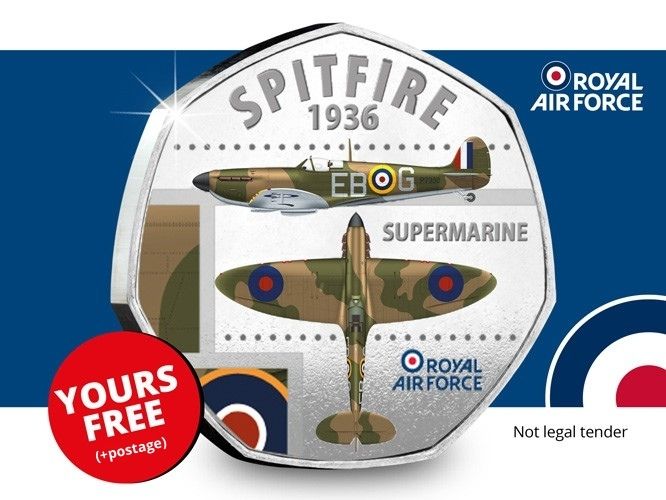Posts Tagged ‘spitfire’
The Spitfire: Birth of a British Aviation Icon

On March 5, 1936, the skies above Hampshire witnessed an event that would reshape the course of aviation and military history. From Eastleigh Aerodrome (now Southampton Airport), the prototype of the Supermarine Spitfire took flight for the very first time—ushering in a new era of fighter aircraft engineering. With its elegant design and formidable performance, the Spitfire would soon become a symbol of British resilience in the face of war.
The Iconic Sound
↓ Hear the iconic sound of a Spitfire fly past. Click Play Below ↓
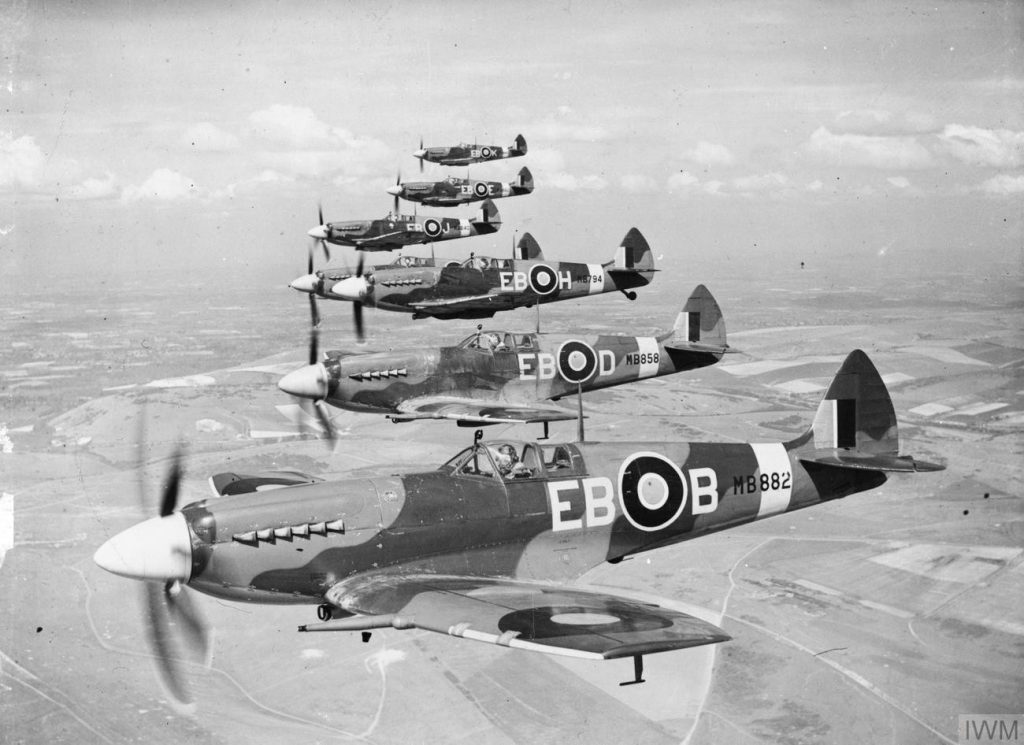
A Revolutionary Aircraft Takes Flight
The Spitfire was the masterpiece of Reginald J. Mitchell, the chief designer at Supermarine Aviation Works, part of Vickers-Armstrongs. Drawing from his experience designing high-speed racing seaplanes for the Schneider Trophy, Mitchell applied the same aerodynamic brilliance to the creation of a revolutionary monoplane fighter.
Did You Know? The Spitfire’s elliptical wing design wasn’t just stylish—it reduced drag and improved lift, giving the aircraft a tighter turning radius and better performance at high speeds than many of its contemporaries.
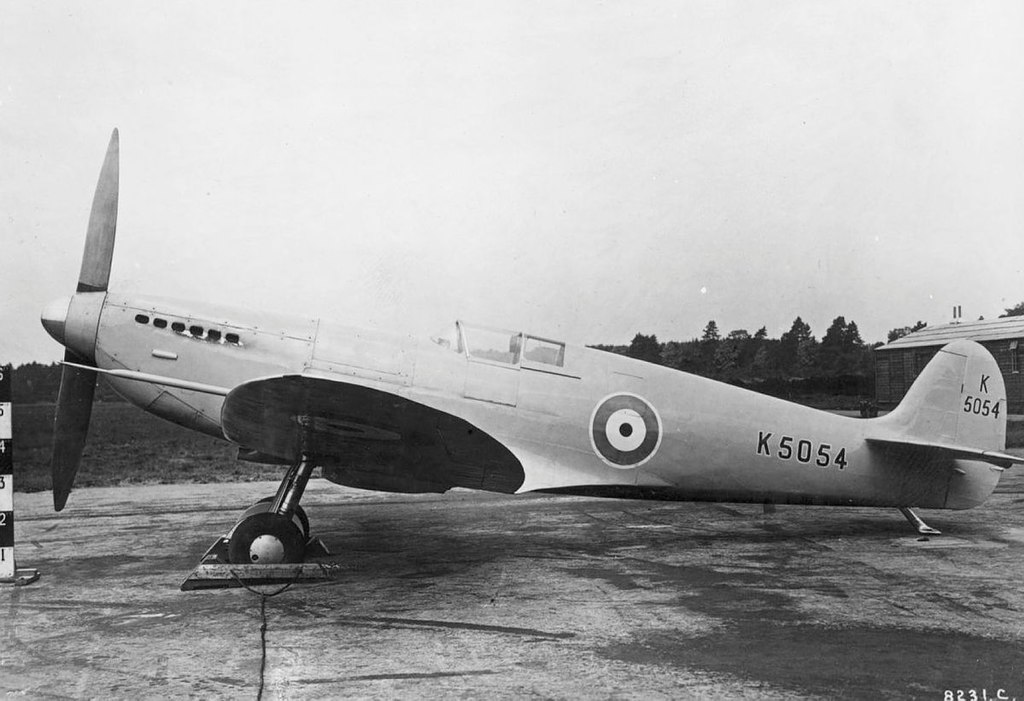
On that historic afternoon, test pilot Captain Joseph “Mutt” Summers climbed into the cockpit of prototype K5054. The aircraft, powered by the Rolls-Royce Merlin engine, performed so well during the short eight-minute maiden flight that Summers famously declared, “I don’t want anything touched!“
From Prototype to Production
The promising performance of the Spitfire’s first flight quickly caught the attention of the British Air Ministry. Just three months later, on June 3, 1936, an order for 310 Spitfires was placed, beginning what would become one of the most celebrated production runs in military aviation.
↑ Click the circles 🔴 in the image above to find out more about each part of the Spitfires Design. ↑
Did You Know? Over 20,000 Spitfires were built between 1936 and 1948, making it the most produced British fighter aircraft of World War II.
Despite early production challenges, the first units reached RAF squadrons by 1938, positioning the Spitfire as a critical asset just as tensions in Europe escalated.
Defender of Britain’s Skies
The Battle of Britain in 1940 cemented the Spitfire’s place in legend. While the Hawker Hurricane bore the brunt of the fighting, the Spitfire was instrumental in duels with the Messerschmitt Bf 109, Germany’s top-tier fighter. Its superior speed, rate of climb, and maneuverability made it a favourite among pilots and a feared opponent in the sky.
Did You Know? The Spitfire’s wings were so thin and strong that eight .303 Browning machine guns were housed within—an innovative feature at the time.
Its agility and speed became not only a tactical advantage but also a psychological one, bolstering the morale of Allied forces and the British public alike.
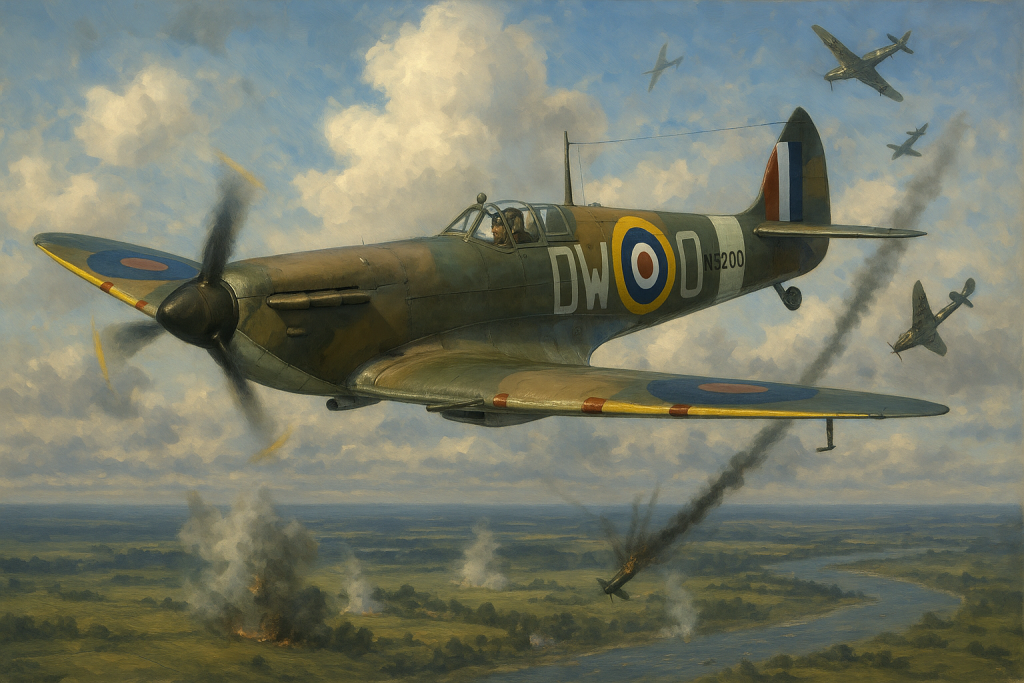
A Versatile and Evolving Design
The Spitfire was never a static design. Instead, it evolved through over 20 major variants, adapting to every phase of the war. As roles shifted, so did the aircraft: from interceptor to photo reconnaissance, from air superiority fighter to carrier-based Seafire.
Did You Know? Some Spitfires were specially equipped with cameras instead of guns and flew unarmed reconnaissance missions, providing vital intelligence over occupied Europe.
Later models even incorporated the Rolls-Royce Griffon engine, pushing the aircraft to greater altitudes and speeds.
The Legacy Lives On
Even decades after the guns fell silent, the Spitfire remains one of the most recognisable and admired aircraft in the world. Dozens of airworthy Spitfires still grace airshows and commemorative events, their distinctive Merlin engine roar still sending chills down the spine of all who hear it.

Did You Know? The name “Spitfire” was suggested by Sir Robert McLean, the then-chairman of Vickers, who reportedly described his spirited daughter as a “little spitfire.”
From wartime hero to timeless icon, the Spitfire continues to represent the innovation, courage, and determination of an era defined by conflict and triumph.
The Supermarine Spitfire’s first flight was more than a test—it was the beginning of a legend. Its combination of engineering brilliance, combat performance, and enduring symbolism has made it one of the most admired aircraft in history. From its role in defending Britain’s skies during World War II to its continued presence at airshows and in the hearts of aviation enthusiasts, the Spitfire is a testament to innovation and bravery.
Celebrate 85 Years Since the Battle of Britain

2025 marks the 85th anniversary of the Battle of Britain—a defining moment in British history where the Spitfire played a heroic role. To commemorate this significant milestone, we invite you to explore our exclusive range of Spitfire commemoratives, honouring both the aircraft and the brave pilots who flew them.
Honouring a legendary war hero — NEW Commemoratives issued to mark the 40th Anniversary of the Douglas Bader Foundation
This year marks 40 years since the founding of the Douglas Bader Foundation. To celebrate the occasion a range of NEW commemoratives have been issued in partnership with the charity. But, before I go into any details about these new issues, I want to tell you about the fascinating life of the foundation’s namesake – Group Captain Sir Douglas Bader.
Sir Douglas Bader
Douglas Bader was born in London in 1910 and was commissioned into the Royal Air Force in 1930. Tragically, 18 months later he was in a plane crash in which he lost both legs.
Due to this accident, he was discharged from the RAF and was forced to find work elsewhere.
However, after the outbreak of the Second World War, Bader was able to rejoin the air force. He became a leading airman during WW2, flying Spitfires and Hurricanes at Dunkirk and the Battle of Britain. In 1941, he was shot down and held as a prisoner of war.
During his descent, Bader lost his right artificial limb. He persuaded his German captors to radio England to ask them to send over a replacement leg. On the night of 19 August 1941, during a normal bombing raid, his new leg was dropped from a Blenheim, along with some stump socks, tobacco, and chocolate.
Despite his disability, he made several escape attempts. Bader was eventually placed in Colditz until its liberation in 1945.
Douglas Bader was a charismatic and controversial character. After the war, he campaigned tirelessly on behalf of amputees and people with disabilities. He inspired millions with his example and was honoured with a knighthood in 1976. He is considered a national hero for both his war efforts and his work with the disabled which he was involved in up until he died in 1982.
The Douglas Bader Foundation
The Douglas Bader Foundation was established immediately following his death in 1982 by his friends and family, many of whom had flown by his side during the war.
For 40 years, the Douglas Bader Foundation has worked to help people with disabilities, supplying prosthetics, grants, and support to many people.
To support this fantastic charity, a donation from the sale of each of the brand-new commemoratives will go directly to the Douglas Bader Foundation.
So, let’s take a closer look at the new range ….
The Silver Spitfire Commemoratives
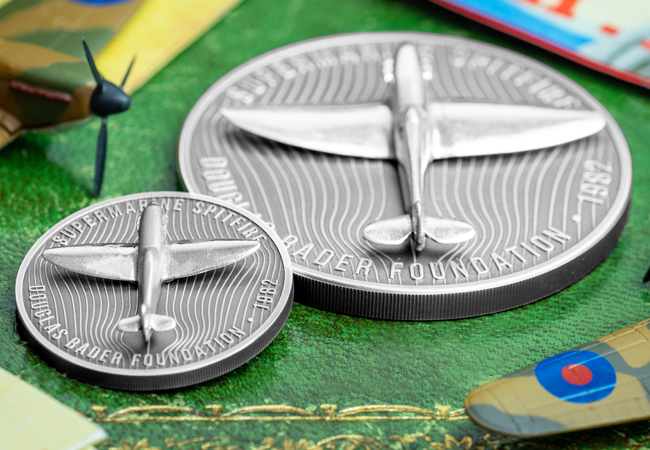
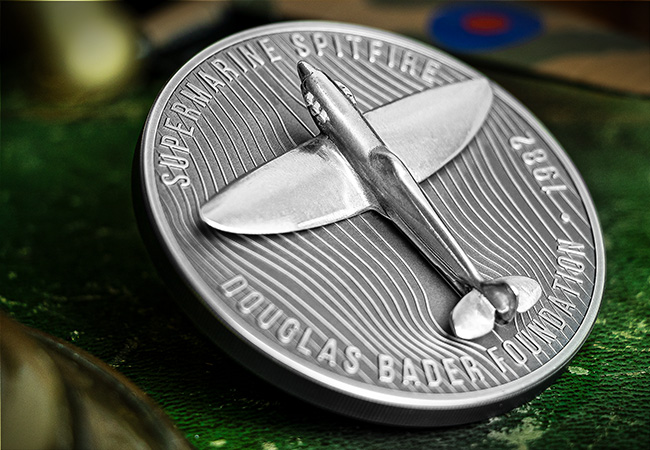
These incredible Silver Spitfire commemoratives feature a 3D Spitfire model crafted from a genuine piece of aluminium from a Spitfire AB910.
AB910 flew in The Dieppe Raid – one of the most significant air battles in history and flew cover patrols over Normandy beachheads on D-Day.
I can’t think of a more fitting tribute to Douglas Bader and the Douglas Bader Foundation. The daring airman flew Spitfires over Dunkirk and during the Battle of Britain.
These are available in both 1oz and 5oz silver specifications. With a small amount of this historic metal available, just a limited number of these commemoratives can be made.
Click here for more details and to secure your 1oz today >>
Click here for more details and to secure your 5oz today >>
Douglas Bader Medal Box Set
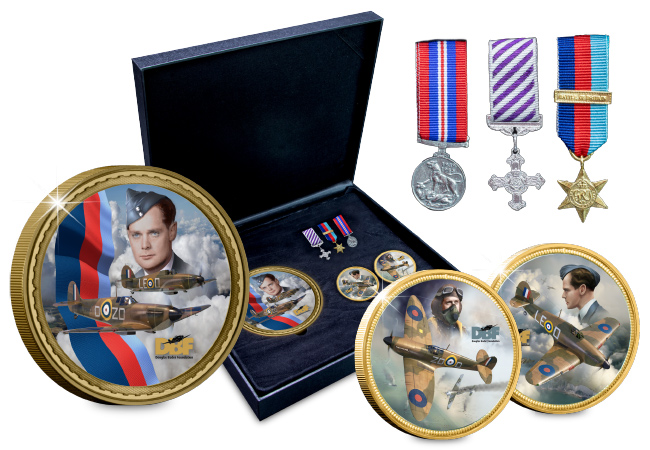
Strictly limited to JUST 250 worldwide, a spectacular box set has been released to honour the extraordinary life of Douglas Bader. This set brings together not one, but three full-coloured commemoratives designed by artist Adam Tooby.
Alongside these commemoratives also sits replicas of three of the many medals that Bader received during his astonishing military career.
As this set comes beautifully displayed in a presentation box with a numbered certificate of authenticity, it is the perfect collector’s piece.
4 monumental aircraft to the Royal Air Force’s history
The birth of the Royal Air Force (RAF) in 1918 was the first time there had been a separate and independent air force established in any country.
It soon became among the most dominant air forces globally.
The 1930’s saw public interest in aircraft increase dramatically and following World War Two (WWII), the demand for the number of aircraft to be built grew quickly in a very short space of time.
Throughout its life, the RAF has monitored the advances in aircraft for military use, and today displays some of the greatest developments in aircraft technology.
For nearly a decade we’ve worked in partnership with the RAF. In that time, we’ve preserved and celebrated over 100 years of history on official commemorative releases.
Let me tell you about 4 aircraft monumental during their existence.
The Sopwith F1 Camel
This Biplane fighter had only one seat and was given the nickname Camel after one squadron commented on its hump like appearance. A comment that would influence its official name.
Carelessness would get you killed in this aircraft.
Pilots had to be skilled to fly it, attentive and observant.
The Camel thrived in daylight but also succeeded at night.
The aircrafts actual nickname?
The King of the Air Fighters.
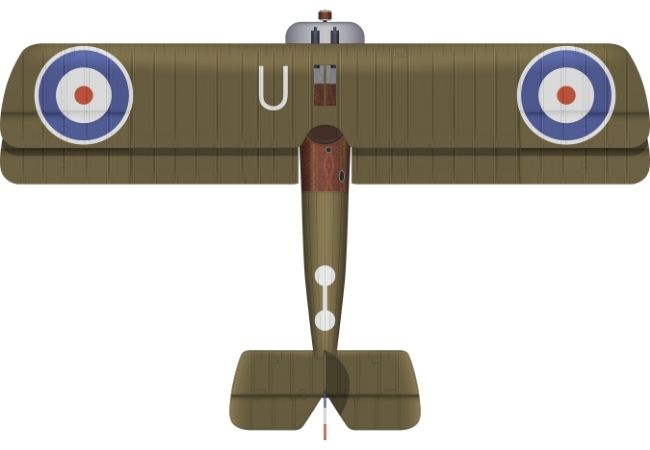
The Avro Lancaster
The Lancaster proved vital towards the end of WWII for Bomber Command. The aircraft helped Britain successfully undermine Nazi Germany from the air.
Lancaster crews risked their lives every time they took to the air in these bombers.
They showed tremendous bravery.
On average they carried out 21 missions before they were lost.
The Eurofighter Typhoon
A vision of the future.
This is how the RAF describe this 21st century Eurofighter Typhoon.
Did you know this aircraft can travel two times faster than the speed of sound? It uses cutting edge technology and has many advanced features.
The UK, Germany, and Italy all worked collaboratively on this aircraft, as they have done also with the tornado project for over several decades.
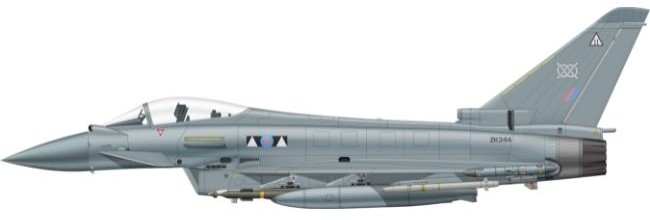
The Spitfire
The Spitfire is by far the most famous British fighter aircraft in history. It was designed by Reginald J Mitchell for the Second World War and there are many reasons why pilots fell in love with it.
It was a symbol of freedom.
The early Mark II could reach speeds of up to 360 mph.
The Spitfires sleek lines and elliptical shaped wings make it perhaps the most graceful fighter ever created.
Did you know that Mitchell’s first attempt to answer the British Air Ministry’s call for an all-metal land-based fighter aircraft was rejected?
It had a cooling system issue.
So, his team tried again.
And boy, did they triumph.
The new design had retractable landing gear, an enclosed cockpit and of course, the thin wing shape.
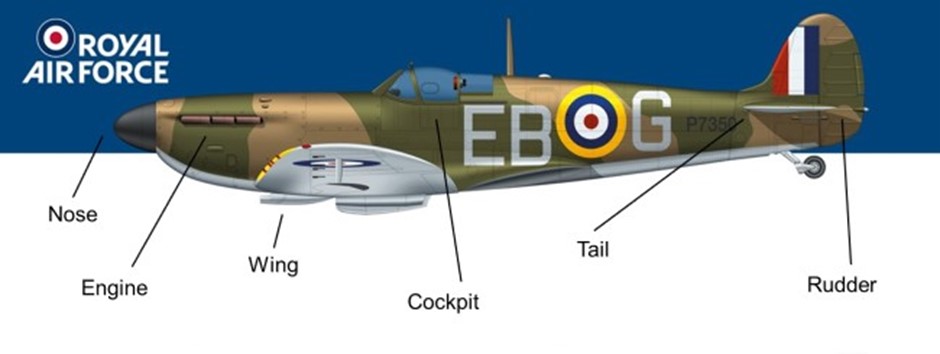
After the first flight of the prototype in 1936 only a few changes were made and by early June, the Air Ministry had ordered 310 Spitfires. By the outbreak of the Second World War, 306 Spitfires were in service with the RAF, along with 71 waiting and 2,000 in the pipeline.
If you’re interested…
The aircraft I have spoken about are intricately illustrated on our collection of commemoratives celebrating the History of the RAF.
The first one in the collection I hear you ask.
Well of course it must be the Spitfire.
Bill Dady, the renowned aviation artist, has designed this one.
Click here to start the History of the RAF Collection by securing your Spitfire Commemorative
for FREE >>

